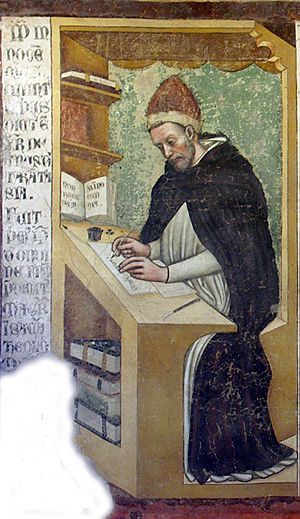Pope Innocent V facts for kids
Quick facts for kids Pope Blessed Innocent V |
|
|---|---|
| Bishop of Rome | |

|
|
| Church | Catholic Church |
| Papacy began | 21 January 1276 |
| Papacy ended | 22 June 1276 |
| Predecessor | Gregory X |
| Successor | Adrian V |
| Orders | |
| Ordination | c. 1259 |
| Consecration | 1272 |
| Created Cardinal | 3 June 1273 |
| Personal details | |
| Birth name | Pierre de Tarentaise |
| Born | c. 1225 Near Champagny-en-Vanoise or La Salle, County of Savoy, Kingdom of Burgundy-Arles, Holy Roman Empire |
| Died | 22 June 1276 (aged 50–51) Rome, Papal States |
| Previous post |
|
| Coat of arms | |
| Sainthood | |
| Feast day | 22 June |
| Venerated in | Catholic Church |
| Title as Saint | Blessed |
| Beatified | 9 March 1898 Rome, Kingdom of Italy by Pope Leo XIII |
| Attributes |
|
| Other Popes named Innocent | |
Pope Innocent V (born Pierre de Tarentaise) was the leader of the Catholic Church and the Papal States from January to June 1276. He was born around 1225 and died on June 22, 1276.
Pierre was a member of the Dominican Order, a group of Catholic priests and brothers. He was known as a very good preacher. He taught at the University of Paris and helped create the study plan for the Dominican Order.
In 1269, he became the head of the French Dominicans. He worked closely with Pope Gregory X, who made him a cardinal in 1273. After Gregory X died, Pierre was chosen as the new Pope. He took the name Innocent V.
His time as Pope was short, only about five months. But during this time, he helped make peace between the city of Genoa and King Charles I of Sicily. Pope Innocent V was later recognized as "Blessed" by Pope Leo XIII in 1898.
Contents
Life Story
Early Years
Pierre de Tarentaise was born around 1225. His birthplace was either near Moûtiers in the Tarentaise region of France or in La Salle in the Aosta Valley in Italy. Both places were part of the Holy Roman Empire back then.
Around 1240, Pierre joined the Dominican Order in Lyons. Later, in 1255, he moved to Paris to study at the University of Paris. He earned a degree in theology and became famous for his preaching.
Teacher and Leader
Between 1259 and 1264, Pierre held an important teaching position for the Dominicans at the University of Paris.
In 1259, he helped create a new study program for the entire Dominican Order. This program focused on studying philosophy before theology. This was a big step for Dominican schools.
Later, some of his ideas were questioned. But Thomas Aquinas, another famous scholar, defended his work. Pierre became the Provincial (leader) of the French Dominicans twice, from 1264-1267 and again in 1269.
In 1272, Pope Gregory X made Pierre the Archbishop of Lyons. He held this role until he became a cardinal.
Becoming a Cardinal
On June 3, 1273, Pope Gregory X made Pierre of Tarantaise a cardinal. He was also named the Bishop of Ostia.
Pierre took part in the Second Ecumenical Council of Lyons in 1274. This was an important meeting of church leaders. He gave the sermon at the funeral of Cardinal Bonaventure during the Council.
After the Council, Pope Gregory X traveled. Pierre was one of the cardinals with him. Pope Gregory X became very ill and died on January 10, 1276.
His Time as Pope
Choosing a New Pope
After Pope Gregory X died, the cardinals met to choose a new Pope. This meeting is called a conclave. On January 21, 1276, Cardinal Pierre of Tarantaise was chosen by everyone. He was the first Dominican to become Pope.
He chose the name "Innocent V." He wanted to be crowned in Rome, which hadn't seen a Pope since 1272. On February 22, 1276, Pope Innocent V was crowned in the Vatican.
What He Did as Pope
Pope Innocent V had a very short time as Pope. He tried to bring peace to Italy.
- He allowed King Charles I of Naples to keep control of Rome.
- He asked Rudolf, the King of the Romans, not to come to Italy yet. He wanted to make an agreement with Rudolf first.
- He helped arrange a peace treaty between the cities of Genoa and Naples. This treaty was signed on June 18, 1276.
- He also worked to reunite the Eastern Church with the Western Church. He sent people to talk with Michael VIII Palaeologus, the Byzantine emperor. He hoped to make peace between the emperor and King Charles I of Naples.
Pope Innocent V died in Rome on June 22, 1276. He had been Pope for about five months. He was buried in the Lateran Basilica. His tomb was later destroyed by fires.
His Writings
Pope Innocent V wrote several books on philosophy and theology. He also wrote about church law. He was known as a very wise scholar.
Becoming Blessed
Pope Leo XIII declared Innocent V "Blessed" on March 9, 1898. This was because of his reputation for being a holy person.
See also
 In Spanish: Inocencio V para niños
In Spanish: Inocencio V para niños

